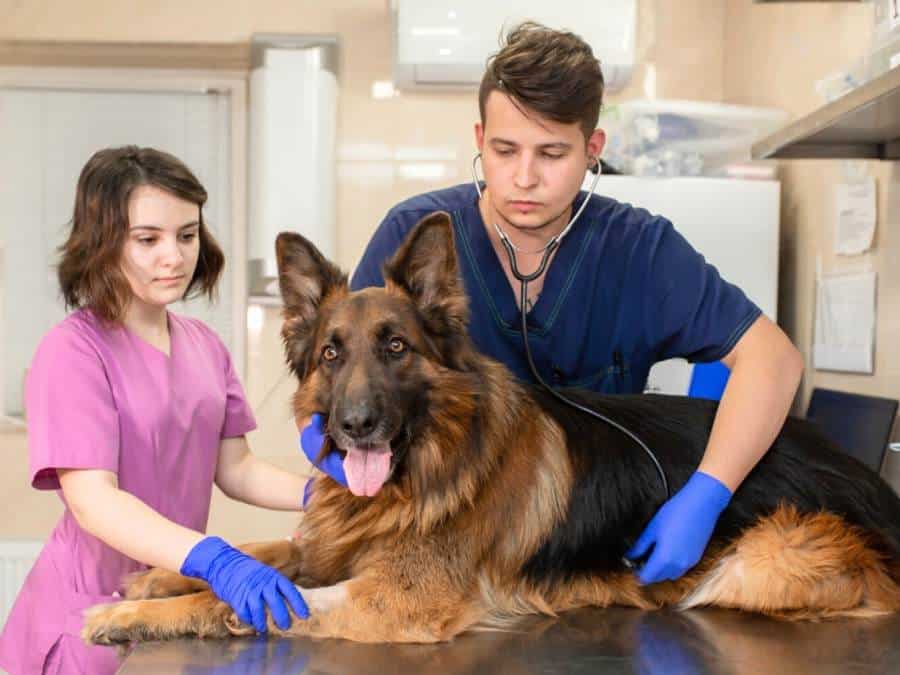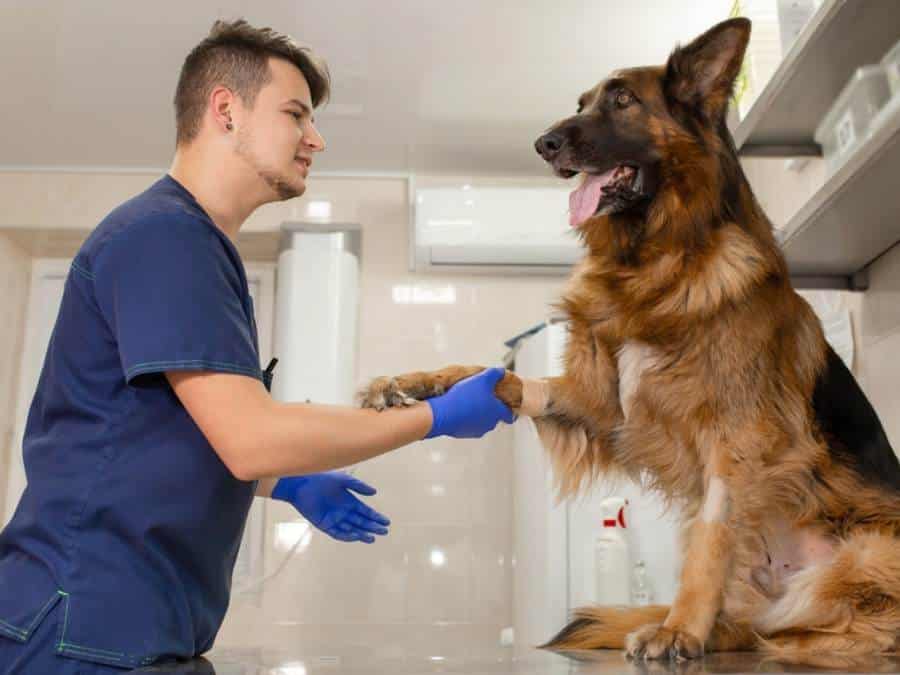Female German Shepherds have an average lifespan of 9 to 13 years. Several factors, such as genetics, diet, exercise, and overall healthcare play crucial roles in determining how long they live.
If you’re a proud owner of a female German Shepherd, or you’re planning to get one soon, Congratulations! You have made a wonderful choice.
Make sure that you read this article till the end as we will be covering topics such as the factors that affect a female German Shepherd’s life expectancy, and we will also discuss serious health issues that can reduce your GSD’s lifespan.
Most importantly, I will give you tips on how you can make sure that your female GSD lives a long and healthy life.
So let’s begin!
How Long Do Female German Shepherds Live?
The average lifespan for the German Shepherd dog breed is 9-13 years. On average, female German Shepherds live to a median of 11.1 years, whereas male German Shepherds have an average lifespan of 9.7 years, which is 1.4 years less than female GSDs. (Source)
That said, it is important to note that the lifespan of any individual dog can vary depending on various factors such as genetics, overall health, diet, exercise, and quality of care.
It is also worth mentioning that some German Shepherds may develop certain health issues as they age, such as hip dysplasia or degenerative myelopathy, which can affect their lifespan.
Therefore, GSD owners like us must be aware of these potential health concerns and take appropriate measures to ensure their dog’s well-being.
RELATED: How Long Do German Shepherds Live?

Factors Influencing Female German Shepherd Lifespan
When it comes to the lifespan of female German Shepherds, several factors can influence how long they live. Understanding these factors can help you provide the best care for your furry friend and ensure they live a long and healthy life.
Let’s take a closer look at some of the key factors that can impact the lifespan of female German Shepherds:
1. Genetics
Like with any breed, genetics play a significant role in determining a German Shepherd’s lifespan. Responsible breeding practices can help reduce the risk of inherited health issues that might shorten their lifespan.
2. Diet and Nutrition
A well-balanced and nutritious diet is fundamental to the health of female German Shepherds. Proper nutrition supports overall well-being, aids in maintaining a healthy weight, and fortifies the immune system.
Tailoring their diet to their specific needs at different life stages is crucial.
3. Exercise and Physical Activity
German Shepherds are an active breed that requires regular exercise to keep them mentally and physically stimulated.
Engaging in activities such as daily walks, playtime, and training sessions can help maintain their muscle tone, prevent weight gain, and promote cardiovascular health.
4. Healthcare and Veterinary Care
Regular visits to the veterinarian for check-ups, vaccinations, and preventive care are crucial for ensuring the well-being of your female German Shepherd.
Routine examinations can help detect any potential health issues early on, allowing for timely treatment and management.
5. Spaying & Reproductive Health
Spaying your female German Shepherd can have a positive impact on her lifespan.
Spaying helps prevent certain reproductive health issues, such as uterine infections and mammary tumors, which can be life-threatening if left untreated.
6. Socialization and Mental Stimulation
German Shepherds are intelligent dogs that thrive on mental stimulation and social interaction.
Providing them with opportunities to engage in training, socialize with other dogs and people, and participate in stimulating activities can contribute to their overall well-being and potentially extend their lifespan.
7. Environmental Factors
The environment in which your female German Shepherd lives can also affect her lifespan. Providing a safe and comfortable living space, protecting her from extreme weather conditions, and minimizing exposure to toxins and hazards can help promote her longevity.
By considering these factors and taking proactive steps to address them, you can help ensure that your female German Shepherd lives a long, healthy, and fulfilling life.
Remember, each dog is unique, and individual care requirements may vary. Consulting with your veterinarian for personalized advice is always recommended.
RELATED:
- What You Must Know Before Getting a Female German Shepherd
- Key Differences Between Male and Female German Shepherd

Health Issues Affecting Female German Shepherd’s Lifespan
Female German Shepherds are prone to certain health issues that can affect their lifespan. Owners need to be aware of these conditions and take appropriate measures to ensure their dog’s well-being.
Here are some common health issues that can impact a female German Shepherd’s lifespan:
- Hip Dysplasia: This is a genetic condition where the hip joint doesn’t develop properly, leading to arthritis and pain. It can be managed with medication, physical therapy, and surgery if necessary.
- Degenerative Myelopathy: This is a progressive disease that affects the spinal cord, resulting in hind limb weakness and paralysis. While there is no cure, supportive care can help manage the symptoms.
- Exocrine Pancreatic Insufficiency: This condition occurs when the pancreas fails to produce enough digestive enzymes, leading to malnutrition and weight loss. It can be managed with enzyme replacement therapy and a special diet.
- Gastric Dilatation-Volvulus: Also known as bloat, this is a life-threatening condition where the stomach fills with gas and twists. Immediate veterinary attention is required to save the dog’s life.
- Hemangiosarcoma: This is a type of cancer that commonly affects German Shepherds. It originates in the blood vessels and can spread rapidly. Early detection and treatment are crucial for improving the prognosis.
- Allergies: German Shepherds are prone to allergies, which can manifest as skin irritations, itching, and digestive issues. Identifying and avoiding allergens, along with medication if necessary, can help manage the symptoms.
- Reproductive Issues: Female German Shepherds may face reproductive health issues, including complications during pregnancy or birth. Responsible breeding practices and prompt veterinary care are essential for managing these issues.
- Thyroid Disorders: Hypothyroidism and hyperthyroidism can affect a dog’s metabolism, leading to weight gain or loss, lethargy, and other symptoms. Medication and regular blood tests can help manage these conditions.
By being aware of these health issues, owners can take proactive steps to ensure the well-being and longevity of their female German Shepherds.
Regular veterinary check-ups, a balanced diet, exercise, and a loving environment can all contribute to a healthier and happier life for these beloved pets.
RELATED: Common German Shepherd Sickness And Symptoms

Tips for Increasing the Lifespan of Female GSDs
As a GSD owner, you want to ensure that your female German Shepherd lives a long and healthy life. Here are some tips to help increase their lifespan:
1. Provide a balanced diet.
A nutritious diet is essential for the overall health of your female GSD. Ensure that their meals include high-quality protein, healthy fats, and a variety of fruits and vegetables.
Avoid feeding them excessive amounts of processed foods or table scraps, as these can lead to weight gain and health issues.
2. Regular exercise.
German Shepherds are an active breed that requires regular exercise to stay fit and mentally stimulated.
Engage in daily activities such as walks, runs, and playtime to keep your female GSD physically and mentally healthy. Regular exercise can help prevent obesity and related health problems.
3. Regular veterinary check-ups.
Schedule regular visits to the veterinarian to monitor your female GSD’s health and catch any potential issues early on.
Vaccinations, dental care, and preventative treatments for parasites are crucial aspects of their overall well-being.
4. Maintain a healthy weight.
Obesity can lead to various health problems in dogs, including joint issues, heart disease, and diabetes.
Keep an eye on your female GSD’s weight and consult with your veterinarian to determine the ideal weight range for her. Feed her appropriate portion sizes and avoid overfeeding.
5. Provide mental stimulation.
German Shepherds are highly intelligent dogs that thrive on mental stimulation.
Engage in activities such as obedience training, puzzle toys, and interactive games to keep their minds sharp and prevent boredom.
6. Grooming and hygiene.
Regular grooming sessions, including brushing their coat, cleaning their ears, and trimming their nails, are essential for maintaining your female GSD’s hygiene and overall health.
7. Socialization and training.
Proper socialization and training from an early age are crucial for German Shepherds. Expose your female GSD to various environments, people, and other animals to ensure they develop into well-adjusted and friendly dogs.
Training sessions can help establish boundaries and prevent behavioral issues.
8. Provide a safe environment.
Create a safe and secure environment for your female GSD by securing fences, removing toxic plants, and keeping harmful substances out of reach.
Supervise them during outdoor activities and ensure they have access to shade and fresh water at all times.
Remember, each dog is unique, and their needs may vary. Consult with your veterinarian for personalized advice and recommendations based on your female GSD’s specific health requirements.
RELATED:

Effects of Spaying/Neutering on Female GSDs Lifespan
Spaying or neutering your female German Shepherd can have a significant impact on her lifespan. This common surgical procedure involves the removal of the reproductive organs, such as the ovaries and uterus in females.
While spaying/neutering is primarily performed for population control and behavioral reasons, it can also contribute to a longer and healthier life for your furry companion.
1. Reduced Risk of Reproductive Diseases: By removing the reproductive organs, you eliminate the possibility of conditions like uterine infections (pyometra) and ovarian cancer.
These diseases can be life-threatening if left untreated, but spaying significantly lowers the chances of them occurring.
2. Prevention of Mammary Tumors: Studies have shown that intact (unspayed) female dogs have a higher risk of developing mammary tumors compared to those who are spayed before their first heat cycle.
The risk decreases with early spaying, providing long-term protection against this type of cancer.
3. Behavioral Benefits: Female dogs in heat may exhibit restless behavior, increased vocalization, and attract unwanted attention from male dogs. Spaying eliminates these behaviors by removing hormonal fluctuations associated with heat cycles.
However, it’s essential to note that there are considerations and potential drawbacks to spaying as well.
RELATED:
- Spaying Your German Shepherd: Timing, Pros & Cons
- German Shepherd Heat Cycle: Length, Frequency, & Stages
Potential Health Risks of Spaying
1. Timing Matters: Some studies suggest that spaying before full maturity might have potential health benefits, while others suggest that waiting until after maturity could be beneficial for certain aspects of development. (Source)
2. Orthopedic and Cancer Risks: There is ongoing research on potential links between spaying and an increased risk of certain orthopedic and cancer issues.
Some studies suggest that spaying before maturity might increase the risk of orthopedic issues, while others indicate potential links to an increased risk of certain cancers, particularly in larger breeds.
3. Weight Gain: Some spayed dogs may be prone to weight gain, which can impact their overall health. Owners should be vigilant about diet and exercise to prevent obesity.
4. Hormonal Changes: Spaying results in hormonal changes, and while this can have behavioral benefits, it may also influence certain aspects of a dog’s health. The long-term effects of these hormonal changes are still an active area of research.
RELATED: German Shepherd Age in Human Years: Calculator + Chart
Conclusion
Proper care plays a vital role in maximizing your female German Shepherd’s lifespan. A balanced diet and regular exercise are essential to ensure their overall health and well-being. It is important to consult with a veterinarian to determine the specific dietary and exercise needs of your German Shepherd, taking into consideration factors such as age, activity level, and any underlying health conditions.
By implementing the strategies we have discussed in this article, you can ensure that your female German Shepherd lives a long, healthy, and fulfilling life.




